
Wildlife of jaguars: behavior, reproduction, and habitat in the Brazilian Pantanal

📋 Índice de Contenido
- 1 Physical Characteristics of the Jaguar (Panthera Onca) in Brazil
- 2 Biological Characteristics of the Jaguar
- 3 Mating of Jaguars in Brazil: Behavior and Reproduction
- 4 Hunting Techniques for Food in the Wildlife of Jaguars
- 5 Jaguar Behavior When Threatened
- 6 Jaguar Diet in Brazil - Pantanal
- 7 Direct Rivals of Jaguars
- 8 Lifespan of Jaguars and Common Diseases in the Wildlife of Jaguars
- 9 Places Where Jaguars Are Most Frequently Found in Brazil
- 10 Photographic Tourism in the Wildlife of Jaguars (In Their Natural Habitat)
- 11 Frequently Asked Questions About wildlife of jaguars and Sightseeing Tours
- 12 Our tours related to wildlife of jaguars
Physical Characteristics of the Jaguar (Panthera Onca) in Brazil
The jaguar (Panthera onca) is the largest feline in the American continent and one of the most iconic species in Brazil. Its presence is particularly notable in the wildlife of jaguars in the Pantanal, where the largest specimens of this species have been recorded.

Size and Weight
The size of the jaguar varies depending on the environment and sex. Generally, males are larger than females. An adult jaguar can measure between 1.10 and 1.85 meters in length (excluding the tail), while the tail can add an additional 45 to 75 centimeters. The shoulder height, from the ground to the shoulders, ranges between 60 and 75 centimeters.
Regarding weight, males in the Pantanal typically weigh between 100 and 140 kilograms, while females weigh between 40 and 90 kilograms. Compared to other regions in Latin America, Pantanal jaguars are among the most robust of the species.
Build and Musculature
The jaguar's body is compact, robust, and highly muscular. This structure provides the strength needed to capture large prey and navigate challenging terrains. Its legs are short and powerful, adapted for ambushing and pouncing with precision. Additionally, they are excellent swimmers, a skill particularly useful in regions like the Pantanal, which feature wetlands and rivers.
Head, Jaw, and Bite
One of the most impressive characteristics of the jaguar is its bite. Its skull is designed to withstand significant pressure, and its jaw is extremely strong. It is estimated to exert over 500 kilograms of force, making it the feline with the most powerful bite relative to its size. This allows it to hunt effectively, even crushing turtle shells or penetrating the skulls of its prey.
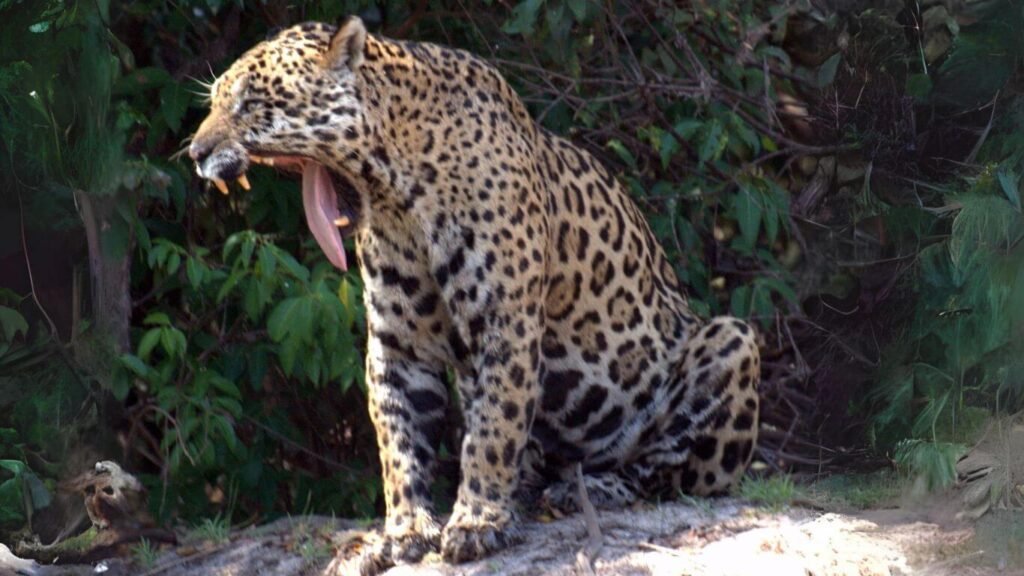
Coat and Patterns
The jaguar's coat is dense and varies in color from golden yellow to light brown. It is covered in black spots that form rosettes, often with a central black dot. This pattern helps it camouflage in dense vegetation. The belly, inner legs, and neck are usually lighter, almost white.
There are also melanistic jaguars, commonly known as "black panthers". Although their coat appears entirely dark, under good lighting, the distinctive rosettes can still be seen. This is due to a genetic variation and does not represent a distinct species.
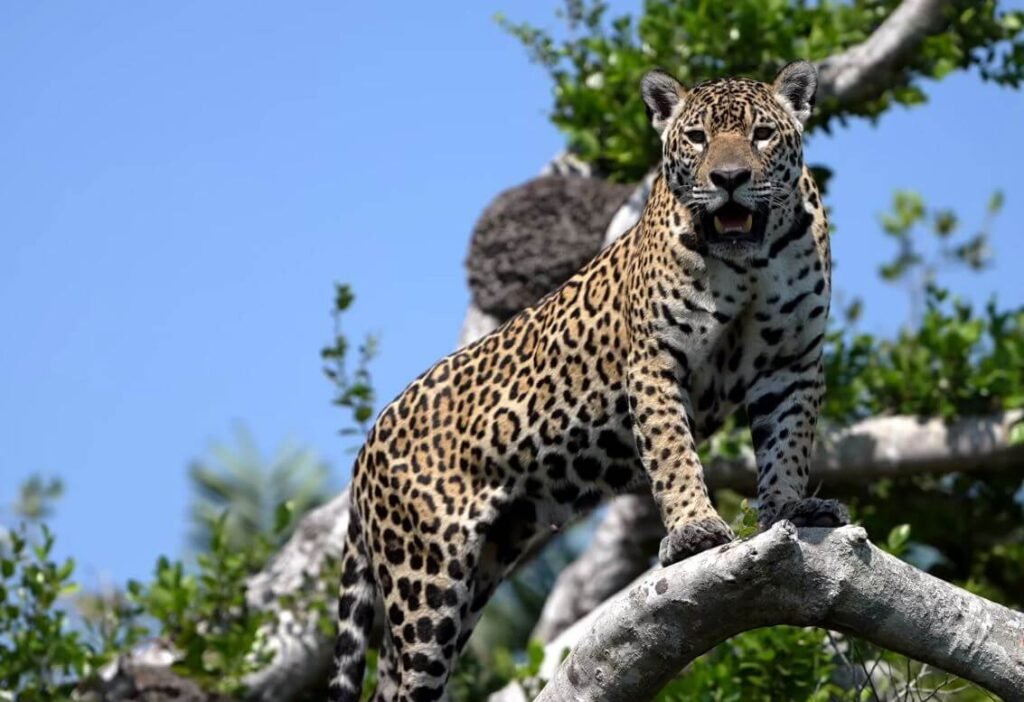
Biological Characteristics of the Jaguar
The jaguar, as a native species of Brazil, plays a crucial role in the ecological balance of the ecosystems it inhabits, primarily the Pantanal, the Amazon, and the Cerrado. As a top predator, its presence regulates the populations of other species and maintains the balance of food chains.
Activity Patterns
Generally, Brazilian jaguars are solitary and mostly nocturnal or crepuscular. This means they are more active at dusk, during the night, and at dawn. However, in areas like the Pantanal, where there is abundant water and less human pressure, it is not uncommon to see them active during the day, especially in the dry season when prey congregate near water sources.
Territory and Movement (wildlife of jaguars)
Each jaguar has a defined territory, which it marks with urine, scratches on trees, and feces. Males tend to have larger territories than females, and their ranges often overlap with those of several females. The size of the territory varies depending on prey density and habitat type: in the Amazon, it can span over 100 km², while in the Pantanal, where prey is more abundant, territories may be smaller.
Jaguars are solitary animals and avoid direct contact with other jaguars, except during mating season or when a female is raising her cubs.

Mating of Jaguars in Brazil: Behavior and Reproduction
The mating behavior in the wildlife of jaguars, particularly in regions like the Pantanal, follows well-defined patterns observed in field studies. Although it is a solitary animal most of the time, during the breeding season, jaguars exhibit specific social behaviors.

Reproductive Cycle and Season
Jaguars do not have a fixed mating season. However, births often coincide with months of greater food availability, especially toward the end of the rainy season. This is because the abundance of prey favors the survival of offspring. Females can go into heat multiple times a year if they do not become pregnant.
Sexual Maturity and Estrus Duration
Females reach sexual maturity between 2 and 2.5 years of age, while males mature later, between 3 and 4 years. During estrus, which lasts between 6 and 17 days, females become more active, mark their territory with urine, and vocalize more frequently to attract potential mates.
Courtship and Male Behavior in the Wildlife of Jaguars
Courtship is not aggressive. The male typically stays near the female for several days. They communicate through growls, rubbing, and walking together. When the female is receptive, copulation occurs, which is brief but may be repeated multiple times during the fertile period.
During mating, it is common for the male to gently bite the female's nape, a behavior typical of big cats. After the reproductive period, the male leaves and does not participate in raising the cubs.
Gestation and Birth
Gestation lasts between 90 and 110 days. Typically, one to two cubs are born, though occasionally up to four may be born. However, most litters consist of only one. The mother chooses a protected location, such as a cave or dense vegetation, to give birth and care for her cubs.
Cub Development
Cubs are born blind and completely dependent on their mother. They open their eyes around 14 days after birth and are nursed for about three months. They remain with their mother for over a year, learning to hunt and survive in their environment.
Around 18 months, young jaguars become independent. Males often travel long distances to establish their own territory, while females may stay closer to their birth area.
Reproduction Frequency in the Wildlife of Jaguars
Females usually have a litter every two years. This interval is determined by both the duration of maternal care and the need for sufficient resources to successfully raise the cubs.
Hunting Techniques for Food in the Wildlife of Jaguars
The jaguar is a highly efficient and opportunistic predator, adapting its hunting techniques to its environment. In Brazil, especially in ecosystems like the Pantanal, the Amazon, and the Cerrado, this feline has developed hunting behaviors that respond to both prey availability and landscape features.

Ambush Hunting
The jaguar's primary hunting strategy is the ambush. This method involves stalking prey silently from a short distance, using dense vegetation as cover. When close enough, the jaguar launches a quick and powerful attack. Thanks to its compact and muscular body, it can deliver significant force in a single leap or swipe.
Attack Precision
One of the jaguar's most distinctive traits is its killing method. Unlike other big cats that typically target the neck or suffocate their prey, the jaguar usually bites directly into the skull, applying enough pressure to pierce it with its canines. This lethal method is possible due to its powerful jaw, considered the strongest among felines relative to its body size.
Common Prey in Brazil
In the Pantanal, one of the regions where jaguars are most visible and studied, their primary prey includes:
- Capybaras (Hydrochoerus hydrochaeris): Large rodents often found near water.
- Caimans (especially Caiman yacare): The jaguar is one of the few felines that dares to hunt these reptiles.
- Pecaries and other medium-sized ungulates.
- Turtles and armadillos: Requiring the jaguar's jaw strength to break their shells.
In more forested areas like the Amazon, their diet may include monkeys, birds, large snakes, and even sloths. The jaguar is an opportunistic animal, so its diet varies depending on the region and season.
Hunting in Aquatic Environments
An outstanding skill of the jaguar is its ability to swim. This allows it not only to move between islands and flooded areas but also to hunt in water. In the Pantanal, for example, it is not uncommon to see jaguars swimming or waiting silently on the shore to ambush a caiman or capybara.
Nocturnal and Solitary Hunting
The jaguar is primarily nocturnal or crepuscular, meaning it hunts during the night or at dawn and dusk. This helps it avoid the heat of the day and makes it easier to surprise prey. It is a solitary hunter: it does not collaborate with other jaguars and only shares its kills in exceptional circumstances, such as between a mother and her cubs.
Jaguar Behavior When Threatened
Although it is a top predator in the food chain, it is not exempt from threats in its natural environment. Its reaction to danger or human presence can vary depending on factors like habitat, the animal's prior experience, and the proximity of the threat.
Elusive and Silent Nature
In the wild, the jaguar is a reserved animal and avoids contact with humans. Its first reaction to a threat is usually to retreat silently, hiding in dense vegetation or moving into hard-to-reach areas. This evasive behavior is especially common in the Amazon, where the jaguar has more opportunities to hide.
Territorial Defense
In regions like the Pantanal, where the habitat is more open and jaguars are more accustomed to human presence (due to wildlife tourism), they may exhibit more tolerant but watchful behavior. They do not attack unless they feel cornered or surprised at close range. Adult males often patrol and mark their territory with urine, scratches on trees, or feces in visible paths, as a warning to other individuals.
Signs of Discomfort or Warning in the Wildlife of Jaguars
When a jaguar feels uncomfortable or threatened, it may display clear signals such as:
- Hissing or deep growls.
- Ears flattened backward.
- Tail flicking or tense body movements.
- Occasional mock charges to scare off intruders.
These behaviors are warnings and rarely escalate into an attack if the intruder retreats.
Behavior Toward Human Threats
In areas where there has been conflict with human activities, such as cattle ranching, jaguars may become more cautious or aggressive. Habitat loss and poaching cause some individuals to react with greater distrust toward humans. However, attacks on people are extremely rare. Most incidents result from chance encounters or involve injured or cornered jaguars.
Mother-Offspring Reactions
Females with cubs may become more protective if they sense their offspring are in danger. In these cases, the jaguar may appear more defiant, but it will usually try to hide or move away to protect its cubs without engaging in direct conflict.
Jaguar Diet in Brazil - Pantanal
The jaguar is an opportunistic carnivore and one of the most efficient apex predators in the Americas. Its diet is broad and varies according to prey availability in its environment. In Brazil, especially in ecosystems like the Pantanal, the Amazon, and the Cerrado, the jaguar takes advantage of the local wildlife richness to sustain itself.
Primary Diet
In the Brazilian Pantanal, where conditions are ideal for observing jaguars, their most frequent prey includes:
- Capybaras (Hydrochoerus hydrochaeris): One of their main food sources due to their abundance, suitable size, and gregarious behavior.
- Caimans (Caiman yacare): Although they pose a risk, Pantanal jaguars have developed skills to hunt these reptiles, attacking the skull directly for a lethal bite.
- Pecaries and deer: Also a regular part of their diet, especially in forested or drier savanna areas.
- Armadillos, large birds, snakes, and fish: Consumed in smaller quantities, particularly when larger prey is scarce.
In the Brazilian Amazon, their diet may include monkeys, tapirs, and sloths, though these prey are harder to catch due to the dense environment and their elusive behavior.
Additionally, their swimming ability allows them to capture aquatic prey or hunt in flooded areas, a behavior frequently observed in the Pantanal during the rainy season.
Feeding Behavior
The jaguar does not always consume its prey in one sitting. It may drag the kill to a safe area and feed over multiple sessions, depending on the size. If undisturbed, it may return to the site where it left the remains. However, in areas with human presence or competition, it may abandon the prey more quickly.
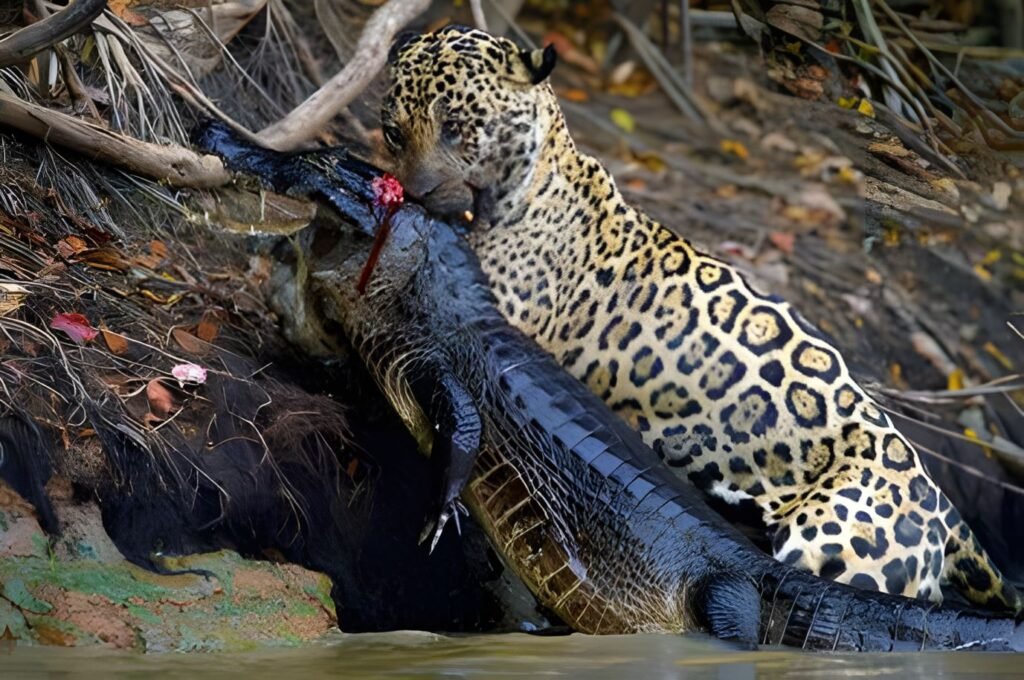
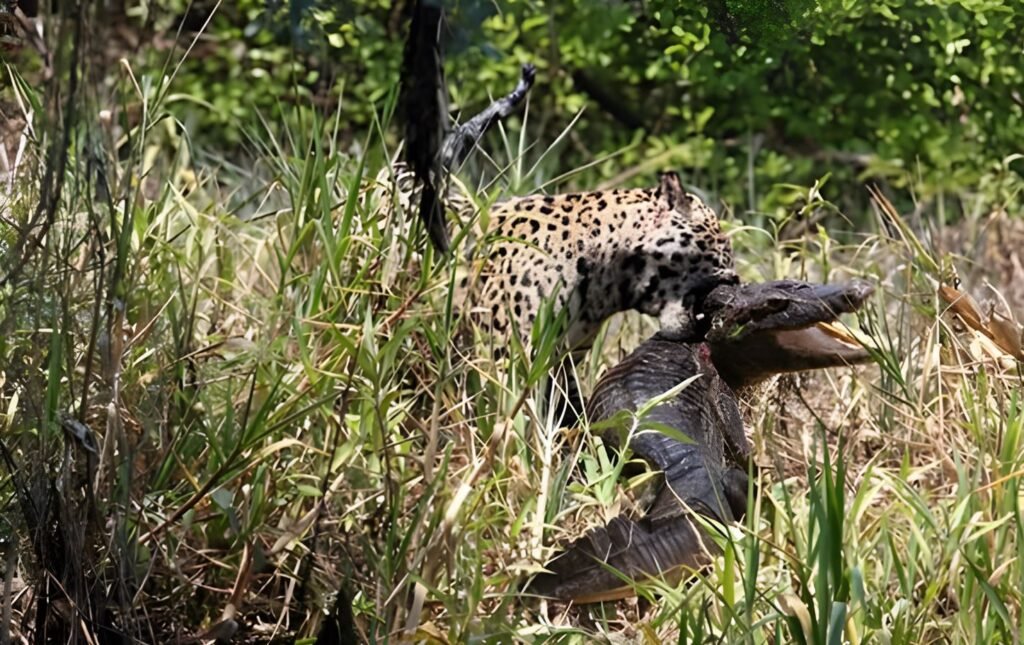
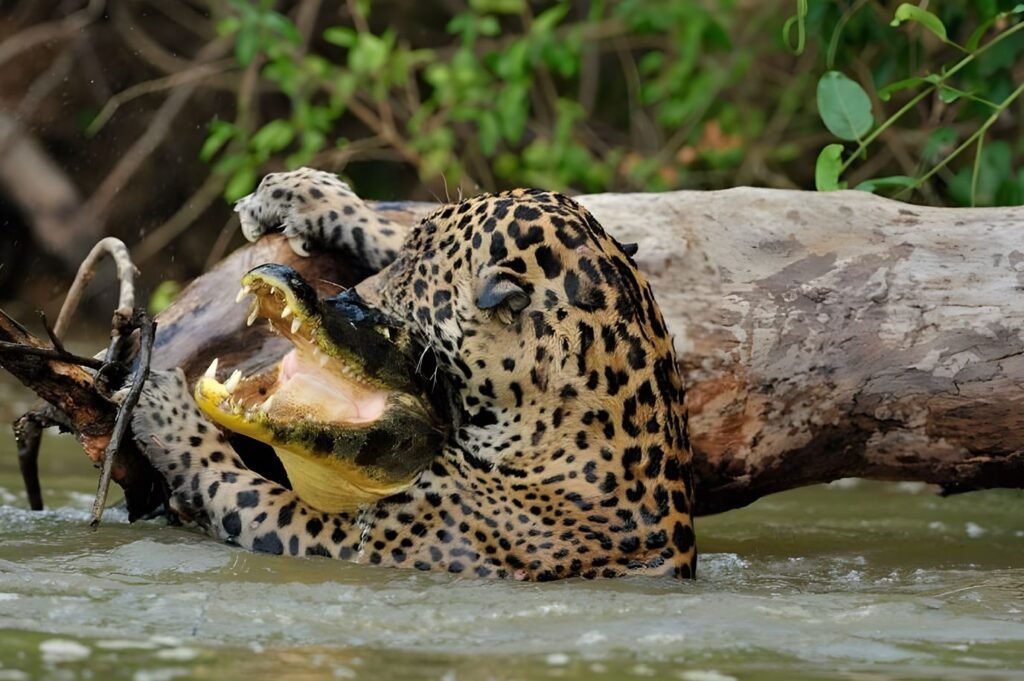
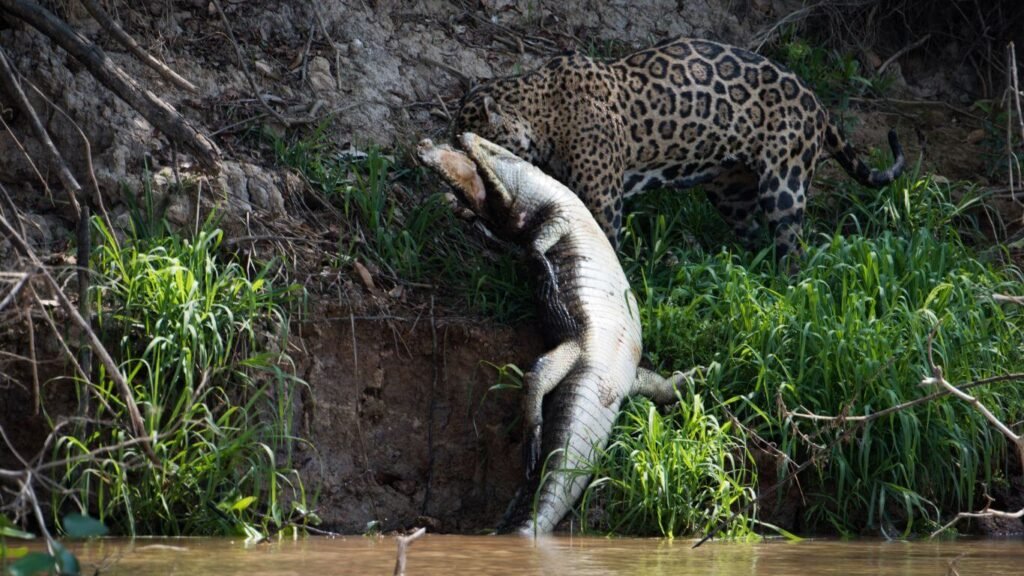
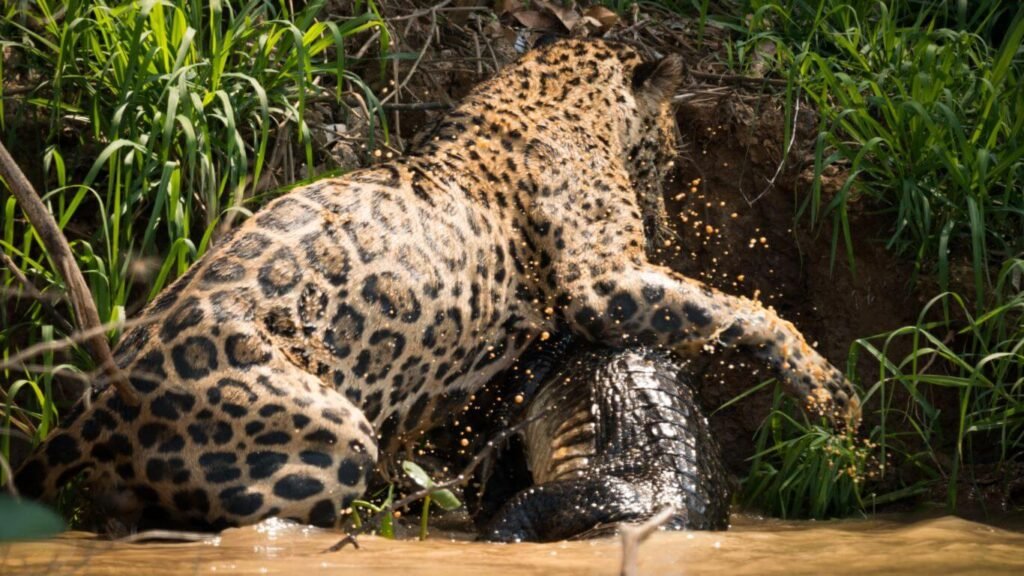
Direct Rivals of Jaguars
In the natural ecosystems of Brazil, the jaguar (Panthera onca) occupies the top of the food chain. It is the dominant apex predator in regions like the Pantanal, the Amazon, and the Cerrado. This means it has very few direct natural competitors. However, there are some species with which it shares territory and may have conflicts, whether over resources, prey, or territory.
Pumas: The Main Natural Competitor
Also known as the mountain lion or cougar, it is the only feline of considerable size that coexists with the jaguar in several regions of Brazil, including the Pantanal and the Atlantic Forest. Although the puma is smaller and less powerful than the jaguar, their dietary habits overlap to some extent.
- Both hunt similar prey, such as deer, peccaries, and armadillos.
- The puma tends to avoid direct encounters with the jaguar, as the latter can be aggressive and territorial.
- In areas where they coexist, the puma often adopts more nocturnal habits or changes its hunting grounds to avoid the jaguar.
- Although there is no evidence of frequent confrontations, there are records of spatial and temporal avoidance by pumas, suggesting indirect competition for resources.
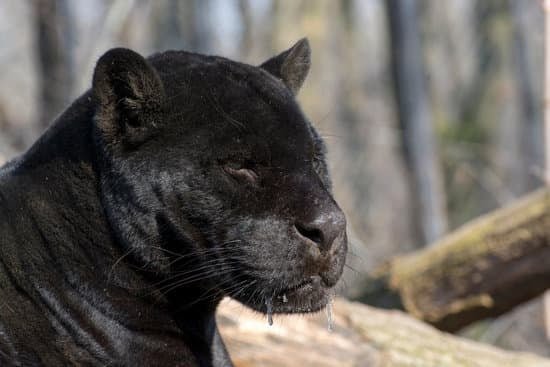
Other Potential Opportunistic Rivals
Besides the puma, other animals may represent occasional competition or take advantage of the jaguar's prey remains:
- Large caimans (Caiman yacare): In the Pantanal, they may compete for the same prey or even pose a risk to young jaguars.
- Scavenger birds like caracaras or vultures: They are not hunting rivals but may interfere with the jaguar's meal if it abandons the remains.
Lifespan of Jaguars and Common Diseases in the Wildlife of Jaguars
As an apex predator, it enjoys a relatively stable life in its natural environment, provided it is not disturbed by human activities. In Brazil, where one of the most stable populations is found in the Pantanal, its longevity patterns and health have been better studied.
Jaguar Lifespan
The life expectancy of the jaguar varies depending on whether it is in the wild or captivity:
- In the wild, Brazilian jaguars can live between 12 and 15 years, though reaching the upper limit depends on factors like food availability, absence of human conflict, and overall health.
- In captivity, they can live up to 20 to 25 years, thanks to veterinary care, controlled diet, and absence of natural threats.
Most studies in the Pantanal indicate that jaguars typically live an average of 12 to 14 years in their natural environment, if they survive the juvenile stage, when they are most vulnerable.
Common Diseases
Although sick jaguars are rarely observed in their natural habitat due to their solitary and territorial lifestyle, some diseases have been identified through research in parks and conservation centers in Brazil:
- Internal and external parasites: such as ticks, intestinal worms, or protozoa. In areas with more contact with domestic animals, the risk of infection increases.
- Viral diseases:
- Feline distemper (CDV virus): has been detected in jaguars near rural populations, due to contact with unvaccinated dogs.
- Feline immunodeficiency virus (FIV): similar to HIV in humans, though its prevalence is low in jaguars.
- Leishmaniasis: a disease transmitted by sandflies. Cases have been detected in wild felines in the Brazilian Amazon and Cerrado.
- Injuries from fights: Jaguars may suffer infections if wounded in territorial conflicts or encounters with other predators (such as caimans in the Pantanal).
Factors Affecting Longevity
Besides diseases, other factors reduce the life expectancy of jaguars in Brazil:
- Habitat fragmentation, especially in the Cerrado and Atlantic Forest.
- Conflicts with ranchers, who sometimes illegally hunt them for attacking livestock.
- Illegal wildlife trafficking: though less common, some young jaguars have been captured by illegal networks.
Places Where Jaguars Are Most Frequently Found in Brazil
Brazil is home to the largest population of jaguars in the world, and the Pantanal is their most important habitat within the country. This biome, considered the largest tropical wetland on the planet, is divided into two main regions: North Pantanal (Mato Grosso) and South Pantanal (Mato Grosso do Sul). Both offer the best ecological conditions for the presence and observation of jaguars in the wild.
North Pantanal: Poconé and Porto Jofre
Poconé: This town is known as the gateway to the North Pantanal. From here, the Transpantaneira highway, a dirt road that crosses the heart of the Pantanal, provides access to various ranches and tourist lodges. The areas near Poconé, with high densities of rivers and dense vegetation, are frequented by jaguars, especially along the banks of water bodies.

Porto Jofre: One of the best places in the world to observe jaguars in the wild. Located at the end of the Transpantaneira, this small port is famous for river safari tours that navigate the Cuiabá River and its tributaries, such as the Três Irmãos River. During the dry season (June to October), visibility is high, and jaguars often appear on the banks to hunt or cool off.
Key features of the North Pantanal:
- High concentration of jaguars per square kilometer.
- Well-established wildlife tourism.
- Great diversity of birds, caimans, capybaras, and giant otters, which ensures a steady presence of jaguars due to the availability of prey.



South Pantanal: Corumbá and Miranda
Corumbá: A border town with Bolivia, it is one of the access points to the South Pantanal. Although jaguar tourism here is not as developed as in the north, frequent encounters have been recorded, especially in more remote or protected areas.
Miranda and Aquidauana: These regions feature rural lodges and ranches that promote eco-tourism. Jaguars are observed in areas of riparian forest and grasslands near the Miranda and Aquidauana Rivers. Access usually requires 4x4 vehicles or boats.
Features of the South Pantanal:
- Lower density of visible jaguars compared to the north, but still present.
- Varied habitats: savannas, riparian forests, and wetlands.
- More exclusive experiences and less crowded.
Other Regions Where Jaguars Live in Brazil (Less Visible)
Although the Pantanal is the most prominent area, jaguars also inhabit other Brazilian regions such as:
- Brazilian Amazon: its size and dense vegetation make sightings more difficult.
- Cerrado: especially in parks like Emas or Chapada dos Guimarães.
- Atlantic Forest: reduced and fragmented presence due to deforestation.
However, none of these areas currently offer the same ease of observation and study of jaguars as the North and South Pantanal, making them the primary points of interest for both researchers and nature tourism.
Photographic Tourism in the Wildlife of Jaguars (In Their Natural Habitat)
The Brazilian Pantanal has become one of the most important destinations in the world for wildlife tourism, especially for observing and photographing jaguars in the wild. The growing presence of specialized agencies, the relative ease of spotting these felines, and the tourist infrastructure in key areas have made this activity a viable and attractive option for nature travelers and professional photographers.
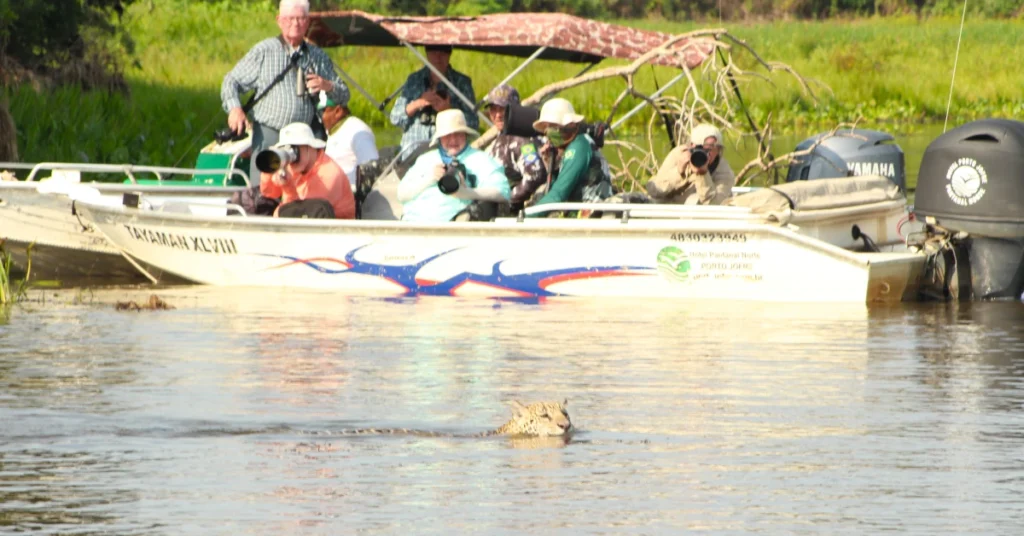
Recommended Seasons
The best time for photographic tourism of jaguars in Brazil is during the dry season, which runs approximately from June to October. During this period:
- The river levels drop, facilitating navigation along their banks.
- Jaguars tend to appear on the shores to hunt or rest.
- The vegetation is less dense, improving visibility.
- There is a higher concentration of wildlife around water sources, increasing the chances of encounters.
The months of August and September are considered the most optimal for observation, due to the frequency of sightings and stable weather conditions.
Best Agencies for These Tours
Several tour operators in the North Pantanal (especially in Poconé and Porto Jofre) offer specialized photographic safaris. While we won't mention specific brands, it's important to note that reputable agencies offer:
- Specialized guides in wildlife.
- Quiet boats equipped with eco-friendly motors.
- Departures at strategic times (morning and afternoon).
- Protocols to avoid disturbing the animals.
It's advisable to book in advance, especially during peak season, and check references from others interested in nature photography.
Additional Species You Can Photograph
In addition to the jaguar, the Pantanal offers a unique diversity of wildlife. During a photographic tour, it's common to observe:
- Capybaras (Hydrochoerus hydrochaeris)
- Yacare caimans (Caiman yacare)
- Giant otters (Pteronura brasiliensis)
- Tapirs (Tapirus terrestris)
- River turtles
- Waterbirds and raptors such as jabirus (Tuiuiú), herons, kingfishers, and hawks
This variety makes the Pantanal a paradise for wildlife photography.
Recommended Lodges and Meals During Jaguar Wildlife Observation
Along the Transpantaneira, from Poconé to Porto Jofre, there are several lodges and fazendas that offer complete packages including accommodation, meals, and daily tours. Many of these lodgings are adapted for photographers and naturalists, featuring:
- Flexible departure times.
- Comfortable spaces for cleaning and charging photographic equipment.
- Abundant local meals (lunch and dinner included).
- Rooms with fans or air conditioning.
In the South Pantanal, accommodations are more rustic, but many also focus on ecotourism. It's recommended to ask if they offer specific packages for jaguar sightings, as not all lodges in that area have this specialization.


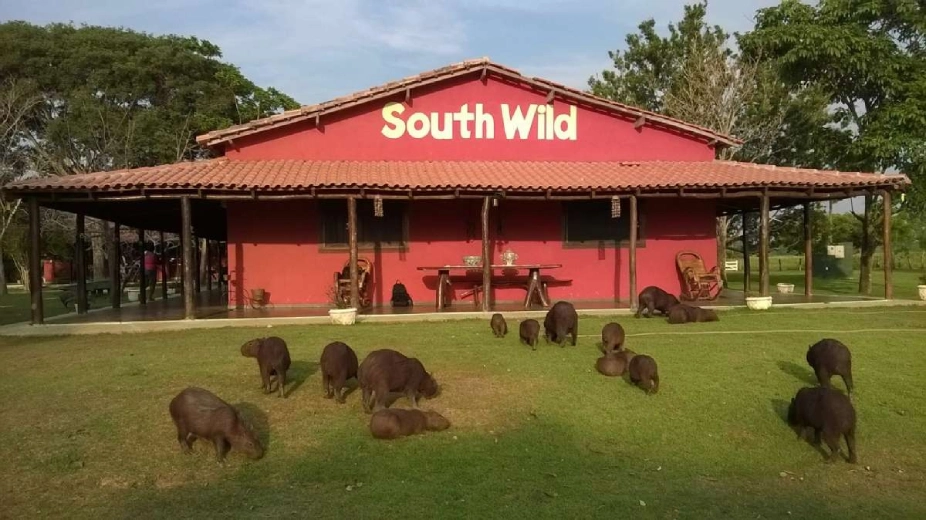
Frequently Asked Questions About wildlife of jaguars and Sightseeing Tours
1. Is it safe to take a jaguar tour in the Pantanal?
Yes, it's safe if done with certified operators. Jaguars are observed from a distance on boats, and the guides are experienced in interpreting their behavior. By following the guide's recommendations, the risk is minimal.
2. How likely is it to see a jaguar during a Pantanal tour?
In the Porto Jofre region, especially during the dry season (June to October), the chances of sightings exceed 80% per outing. However, since they are wild animals, there are no guarantees. That's why multiple outings are recommended.
3. Do I need a professional camera for photographic safaris in the Pantanal?
It's not mandatory. A camera with good zoom improves photos, but some jaguars come close enough for good shots with a compact camera or smartphone. The important thing is to protect your equipment from heat and humidity.
4. What should I bring on a wildlife of jaguars tour in Brazil?
Light long-sleeved clothing, insect repellent, sunscreen, hat, water, and binoculars. Tours usually include meals, but it's useful to bring snacks and a small backpack.
5. Can I do the tour on my own without an agency in Brazil's Pantanal?
It's not recommended. Key areas like Porto Jofre have limited access and require local expertise. Agencies handle transportation, accommodation, and permits, and they also contribute to local conservation.
Want to know more or have any questions? Contact us, ask for Lorenzo.
Our tours related to wildlife of jaguars
Random Posts

Personalized visit to Machu Picchu

Destinos de pesca deportiva en Brasil

 English
English  Español
Español  Português
Português 
 English
English 










































